 W
WInanna is an ancient Mesopotamian goddess associated with love, beauty, sex, war, justice and political power. She was originally worshiped in Sumer under the name "Inanna", and was later worshipped by the Akkadians, Babylonians, and Assyrians under the name Ishtar. She was known as the "Queen of Heaven" and was the patron goddess of the Eanna temple at the city of Uruk, which was her main cult center. She was associated with the planet Venus and her most prominent symbols included the lion and the eight-pointed star. Her husband was the god Dumuzid and her sukkal, or personal attendant, was the goddess Ninshubur.
 W
WThe Agušaya Hymn or Song of Agušaya is an Old Babylonian literary work, a “song of praise”, written in the Akkadian language concerning the goddess Ištar, identified with the serpent deity Irnina. It may have been called “the Snake has Turned” in antiquity, as it has ú-ta-ar MUŠ inscribed at the top edge at the beginning. It is extant on two unprovenanced tablets, designated A and B, the latter of which includes a request for eternal life for king Hammurabi, on the fifth column, 26th line, for whom it is thought to have been composed as an epic hymn of celebration of “the mad dancer in battle”. It is arranged into ten kirugú-stanzas and six ĝešgiĝal-antiphons as lyrical retorts, the numbering of which suggest that the work extends over the two tablets, although the second may not be the actual sequel of the first as the first is an eight column tablet while the second only has six columns and there are apparently subtle differences in late Old Babylonian cursive cuneiform distinguishing them, suggesting tablet A is the younger copy.
 W
WThe Ain Dara temple, located near the village of Ain Dara, in Afrin, Syria is an Iron Age Syro-Hittite temple noted for its similarities to Solomon's Temple, also known as the First Temple, as described in the Hebrew Bible. According to the excavator Ali Abu Assaf, it was in existence from 1300 BC until 740 BC and remained "basically the same" during the period of the Solomonic Temple's construction as it had been before, so that it predates the Solomon Temple. The temples of Emar, Mumbaqa, and Ebla are also comparable, as is the nearby 8th-century Tell Tayinat temple. The surviving sculptures depict lions and sphinxes.
 W
WAnahita is the Old Persian form of the name of an Iranian goddess and appears in complete and earlier form as Aredvi Sura Anahita, the Avestan name of an Indo-Iranian cosmological figure venerated as the divinity of "the Waters" (Aban) and hence associated with fertility, healing and wisdom.There is also a temple named Anahita in Iran. Aredvi Sura Anahita is Ardwisur Anahid or Nahid in Middle and Modern Persian, and Anahit in Armenian. An iconic shrine cult of Aredvi Sura Anahita was – together with other shrine cults – "introduced apparently in the 4th century BCE and lasted until it was suppressed in the wake of an iconoclastic movement under the Sassanids."
 W
WIn Akkadian mythology, Antu or Antum is a Babylonian goddess. She was the first consort of Anu, and the pair were the parents of the Anunnaki and the Utukki. Antu was a dominant feature of the Babylonian akit festival until as recently as 200 BC, her later pre-eminence possibly attributable to identification with the Greek goddess Hera. Antu was replaced as consort by Ishtar or Inanna, who may also be a daughter of Anu and Antu. She is similar to Anat.
 W
WAstarte is the Hellenized form of the Ancient Near Eastern goddess Ashtart or Athtart, a deity closely related to Ishtar, worshipped from the Bronze Age through classical antiquity. The name is particularly associated with her worship in the ancient Levant among the Canaanites and Phoenicians, though she was originally associated with Amorite cities like Ugarit and Emar, as well as Mari and Ebla. She was also celebrated in Egypt, especially during the reign of the Ramessides, following the importation of foreign cults there. Phoenicians introduced her cult in their colonies on the Iberian Peninsula.
 W
WAṯtar is an ancient Semitic deity whose role, name, and even gender varied by culture. Depicted as either male or female, the deity was identified with the planet Venus. In pre-Islamic Southern Arabia, he was worshipped as a god of war.
 W
WBlood Feast is a 1963 American splatter film. It was composed, shot and directed by Herschell Gordon Lewis, written by Allison Louise Downe from an idea by Lewis and David F. Freidman, and stars Mal Arnold, William Kerwin, Connie Mason, and Lyn Bolton. The plot focuses on a psychopathic food caterer named Fuad Ramses (Arnold) who kills women so that he can include their body parts in his meals and perform sacrifices to his "Egyptian goddess" Ishtar.
 W
WBlood Feast 2: All U Can Eat is a 2002 slasher splatter film directed by Herschell Gordon Lewis and starring John McConnell, Mark McLachlan, Melissa Morgan, Toni Wynne, and J.P. Delahoussaye. It is the sequel to the 1963 film Blood Feast. Filmed under a working title of Blood Feast 2: Buffet of Blood and using the same grindhouse style as its predecessor, the film continues the story began in the original film, where a grandson of Fuad Ramses attempts to restart his grandfather's catering business. The film depicts the killer falling victim to spirit possession by the goddess Ishtar.
 W
WThe Burney Relief is a Mesopotamian terracotta plaque in high relief of the Isin-Larsa period or Old-Babylonian period, depicting a winged, nude, goddess-like figure with bird's talons, flanked by owls, and perched upon two lions.
 W
WA crescent shape is a symbol or emblem used to represent the lunar phase in the first quarter, or by extension a symbol representing the Moon itself.
 W
WThe Dance of the Seven Veils is Salome's dance performed before Herod II. It is an elaboration on the biblical story of the execution of John the Baptist, which refers to Salome dancing before the king, but does not give the dance a name.
 W
WDoves, usually white in color, are used in many settings as symbols of love, peace or as messengers. Doves appear in the symbolism of Judaism, Christianity, Islam and Paganism, and of both military and pacifist groups.
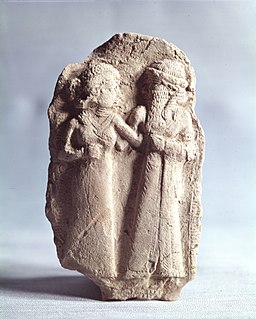 W
WDumuzid or Dumuzi, later known by the alternative form Tammuz, is an ancient Mesopotamian god associated with shepherds, who was also the primary consort of the goddess Inanna. In Sumerian mythology, Dumuzid's sister was Geshtinanna, the goddess of agriculture, fertility, and dream interpretation. In the Sumerian King List, Dumuzid is listed as an antediluvian king of the city of Bad-tibira and also an early king of the city of Uruk.
 W
WE-sara (Cuneiform: E2 SAR.A 𒂍𒊬𒀀 "House of the Universe"), was the temple dedicated to Inanna in Uruk by Ur-Nammu (reigned c. 2112 BC – 2094 BC).
 W
WE-anna was an ancient Sumerian temple in Uruk. Considered "the residence of Inanna" and Anu, it is mentioned several times in the Epic of Gilgamesh, and elsewhere. The evolution of the gods to whom the temple was dedicated is the subject of scholarly study.
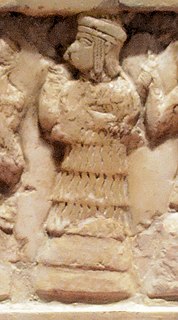 W
WEnheduanna is the earliest known poet whose name has been recorded. She was the High Priestess of the goddess Inanna and the moon god Nanna (Sīn). She lived in the Sumerian city-state of Ur.
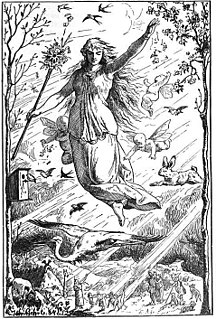 W
WĒostre is a West Germanic spring goddess. By way of the Germanic month bearing her name, she is the namesake of the festival of Easter in some languages. Ēostre is attested solely by Bede in his 8th-century work The Reckoning of Time, where Bede states that during Ēosturmōnaþ, pagan Anglo-Saxons had held feasts in Ēostre's honour, but that this tradition had died out by his time, replaced by the Christian Paschal month, a celebration of the resurrection of Jesus.
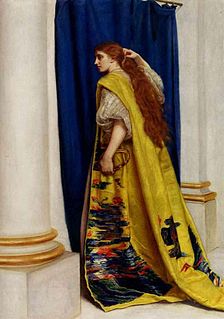 W
WEsther is a female given name known from the Jewish queen Esther, eponymous heroine of the Book of Esther.
 W
WThe Gala were priests of the Sumerian goddess Inanna. They made up a significant number of the personnel of both temples and palaces, the central institutions of Mesopotamian city states. These were thought in modern times to have been individuals with neither male nor female gender identities.
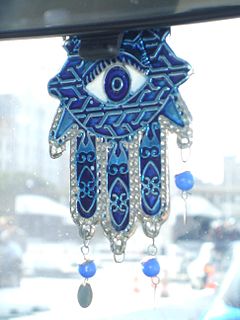 W
WThe hamsa is a palm-shaped amulet popular throughout the Maghreb and in the Middle East and commonly used in jewelry and wall hangings. Depicting the open right hand, an image recognized and used as a sign of protection in many times throughout history, the hamsa is believed by middle easterners, to provide defense against the evil eye. The hamsa holds recognition as a bearer of good fortune among Christians in the Middle East as well.
 W
WHieros gamos or Hierogamy is a sacred marriage that plays out between a god and a goddess, especially when enacted in a symbolic ritual where human participants represent the deities.
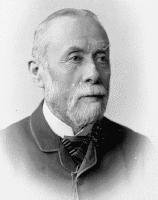 W
WAlexander Hislop was a Free Church of Scotland minister known for his criticisms of the Roman Catholic Church. He was the son of Stephen Hislop, a mason by occupation and an elder of the Relief Church. Alexander's brother was also named Stephen Hislop and became well known in his time as a missionary to India and a naturalist.
 W
WIntolerance is a 1916 epic silent film directed by D. W. Griffith. Subtitles include Love's Struggle Throughout the Ages and A Sun-Play of the Ages.
 W
WIshara is an ancient deity of unknown origin from the north of modern Syria. She first appeared in Ebla and was incorporated into the Hurrian pantheon, from which she found her way to the Hittite pantheon. She appears in documents and personal names from Mesopotamia starting with the end of the 3rd millennium BCE, and had temples in Nippur, Sippar, Kish, Harbidum, Larsa, and Urum.
 W
WThe Ishtar Gate (Arabic: بوابة عشتار) was the eighth gate to the inner city of Babylon. It was constructed in about 575 BCE by order of King Nebuchadnezzar II on the north side of the city. It was part of a grand walled processional way leading into the city. The walls were finished in glazed bricks mostly in blue, with animals and deities in low relief at intervals, these also made up of bricks that are molded and colored differently.
 W
WIshtar Terra is one of the three continental regions on the planet Venus, the others being Aphrodite Terra and Lada Terra. It is a highland region named after the Akkadian goddess Ishtar, and is found in the north of the planet. In size, it is roughly between Australia and the contiguous United States, making it the second-largest of the terrae.
 W
WIstanbul #2461 is an ancient Sumerian cuneiform tablet which is believed to contain the oldest love poem ever found. It is on display at the Istanbul Museum of the Ancient Orient.
 W
WJoseph and His Brothers is a four-part novel by Thomas Mann, written over the course of 16 years. Mann retells the familiar stories of Genesis, from Jacob to Joseph, setting it in the historical context of the Amarna Period. Mann considered it his greatest work.
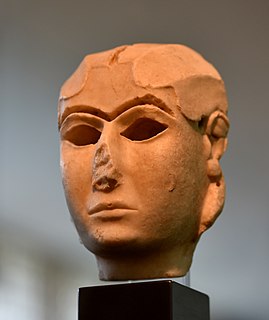 W
WThe Mask of Warka, also known as the Lady of Uruk, dating from 3100 BC, is one of the earliest representations of the human face. The carved marble female face is probably a depiction of Inanna. It is approximately 20 cm tall, and was probably incorporated into a larger wooden cult image, though it is only a presumption that a deity is represented. It is without parallels in the period. It is in the National Museum of Iraq, having been recovered undamaged after being looted when the United States invaded Iraq in 2003.
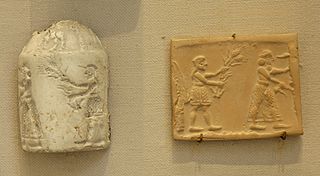 W
WMeshkiangasher was a mythological king only mentioned in the Sumerian King List as the priest of the Eanna temple in Uruk, whose journey led him to the enter the sea and ascend the mountains.
 W
WThe Mole People is a 1956 American science fiction adventure film distributed by Universal International, which was produced by William Alland, directed by Virgil W. Vogel, and stars John Agar, Hugh Beaumont, and Cynthia Patrick. The story is written by László Görög. The film was released on December 1, 1956, on a double feature with their jungle adventure film Curucu, Beast of the Amazon. It has also been featured on episodes of Mystery Science Theater 3000 and Svengoolie.
 W
WNana was a Bactrian female divinity from ancient Bactria, a variation of pan-Asiatic Nana, a conflation of Sumero-Babylonian Inanna-Ishtar with a local divinity, in her Kushan form with the indigenous (Zoroastrian) Harahvati Aredvi Sura Anahita. Such syncretism was common among the Kushan deities.
 W
WNanaya was a Mesopotamian goddess of love, closely associated with Inanna.
 W
WNarundi was a goddess of the city of Susa in Elam. A statue of her is located in the Louvre Museum, where she appears seated on a lion throne, holding a cup and the branch of a palm tree in her hand. She is quite similar to the Sumerian goddess Inanna, and the style of the sculpture itself is reminiscent of Mesopotamian art. According to assyriologist Frans Wiggermann, she was associated with the Sebitti in Mesopotamia, and was sometimes conflated with Ishtar or Nanaya in this context.
 W
WNinatta and Kulitta were two goddesses always invoked together who formed the core of the entourage of the Hurrian goddess Shaushka, the equivalent of Mesopotamian Ishtar. Like many Hurrian deities they were incorporated into the Hittite pantheon, and are among the gods depicted in the Yazilikaya sanctuary. The veneration of Ninatta and Kulitta as a pair is an example of a process common in Hurrian religion, in which a pair of related gods was believed to act as an unity and was therefore venerated together.
 W
WNinshubur was the sukkal (vizier) of the goddess Inanna in Sumerian mythology. Ninshubur also served as the vizier of the sky god An and by extension as the messenger of the assembly of the gods, similar to Greek Hermes or Iris. Her name means "Queen of servants" or "Queen of Subartu" in Sumerian.
 W
WPinikir, also known as Pinigir, Pirengir or Pininkir, was an Elamite goddess. She was called kikki gilira, "mistress of heaven."
 W
WThe Quest of Ki is a 1988 video game developed by Game Studio and published by Namco for the Family Computer. It is the third game in Babylonian Castle Saga series which started with the 1984 arcade game, The Tower of Druaga.
 W
WRed River , also known as Anatolia Story, is a Japanese shōjo manga series by Chie Shinohara. It is published in Japan by Shogakukan in Sho-Comi and collected in 28 volumes. It is published in English in North America by Viz Media, with 25 volumes released as of April 2009 and the remaining 3 published thereafter. In 2000, the series won the Shogakukan Manga Award for shōjo.
 W
WSacred prostitution, temple prostitution, cult prostitution, and religious prostitution are rites consisting of paid intercourse performed in the context of religious worship, possibly as a form of fertility rite or divine marriage. Scholars prefer the terms "sacred sex" or "sacred sexual rites" in cases where payment for services is not involved.
 W
WBrief Lives (1994) is the seventh collection of issues in the DC Comics series, The Sandman. Written by Neil Gaiman, penciled by Jill Thompson, inked by Vince Locke and Dick Giordano, coloured by Daniel Vozzo, lettered by Todd Klein, with cover art by Dave McKean. The introduction was written by Peter Straub but was published as an afterword; Gaiman wrote a brief introduction explaining this.
 W
WIn Sumerian religion Shara, Šara is a minor god of war, mainly identified with the city of Umma, north-east of Unug (Uruk). He is identified in some texts as the son of Inanna (Ishtar).
 W
WThe Ship of Ishtar is a fantasy novel by American writer A. Merritt. Originally published as a magazine serial in 1924, it has appeared in book form innumerable times. The novel depicts a modern archaeologist who has to intervene in an eternal conflict between the deities Ishtar and Nergal. In the novel, the deities have possessed the bodies of their human priests.
 W
WThe star and crescent is an iconographic symbol used in various historical contexts, including as a prominent symbol of the Ottoman Empire, with numerous modern countries still using it as a national symbol. It was developed in the Greek colony of Byzantium ca. 300 BCE, though it became more widely used as the royal emblem of Mithradates VI Eupator after he incorporated Byzantium into his kingdom for a short period. During the 5th century, it was present in coins minted by the Persian Sassanian Empire, the symbol was represented in the coins minted across the empire throughout the middle east for more than 400 years from the 3rd century until the fall of the Sassanians after the Muslim conquest of Persia in the 7th century. The conquering Muslim rulers kept the symbol in their coinage during the early years of the caliphate as the coins were exact replicas of the Sassanian coins. It is the conjoined representation of a crescent and a star, both elements have a long prior history in the iconography of the Ancient Near East as representing either the Sun and Moon or the Moon and Morning Star. Coins with crescent and star symbols represented separately have a longer history, with possible ties to older Mesopotamian iconography. The star, or Sun, is often shown within the arc of the crescent ; In numismatics in particular, the term crescent and pellet is used in cases where the star is simplified to a single dot.
 W
WThe Star of Ishtar or Star of Inanna is a symbol of the ancient Sumerian goddess Inanna and her East Semitic counterpart Ishtar. Alongside the lion, it was one of Ishtar's primary symbols. Because Ishtar was associated with the planet Venus, the star is also known as the Star of Venus.
 W
WThe Timewyrm is the name of a recurring villain from the Virgin New Adventures spin-off novels based on the BBC science fiction television series Doctor Who. The character featured in a four-novel story arc: Timewyrm: Genesys, Timewyrm: Exodus, Timewyrm: Apocalypse and Timewyrm: Revelation.
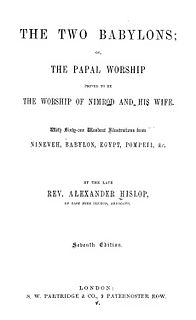 W
WThe Two Babylons, subtitled Romanism and its Origins, is a religious pamphlet published in 1853 by the Presbyterian Free Church of Scotland theologian Alexander Hislop (1807–65).
 W
WThe Uruk Trough is an important Sumerian sculpture found at the site of Uruk, Iraq. It has been part of the British Museum's collection since 1928. Along with the Uruk Vase, the trough is considered to be one of the earliest surviving works of narrative relief sculpture from the Middle East, dating to 3300-3000 BC, during the Uruk period. Simple relief sculpture is known from much earlier periods, from the site of Göbekli Tepe, dating to circa 9000 BC.
 W
WThe Warka Vase or Uruk vase is a slim carved alabaster vessel found in the temple complex of the Sumerian goddess Inanna in the ruins of the ancient city of Uruk, located in the modern Al Muthanna Governorate, in southern Iraq. Like the Uruk Trough and the Narmer Palette from Egypt, it is one of the earliest surviving works of narrative relief sculpture, dated to c. 3200–3000 BC. Simple relief sculpture is also known from much earlier periods, from the site of Göbekli Tepe, dating to circa 9000 BC.
 W
WZabala, also Zabalam was a city of ancient Sumer in what is now the Dhi Qar governorate in Iraq. Zabala was at the crossing of the ancient Iturungal and Ninagina canals, not far from Umma. The city's deity was Inanna of Zabala.